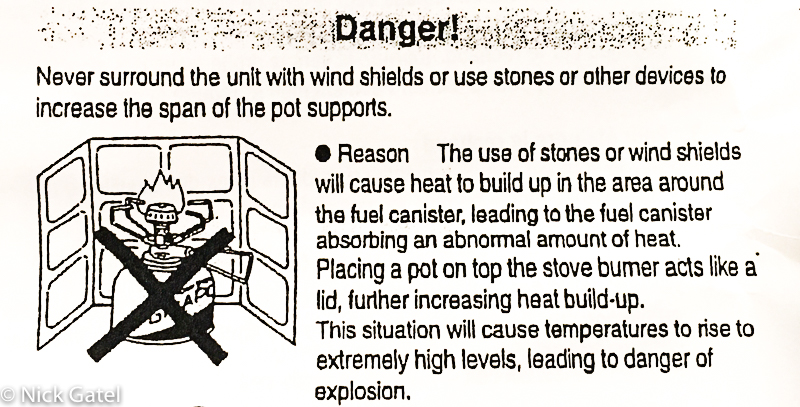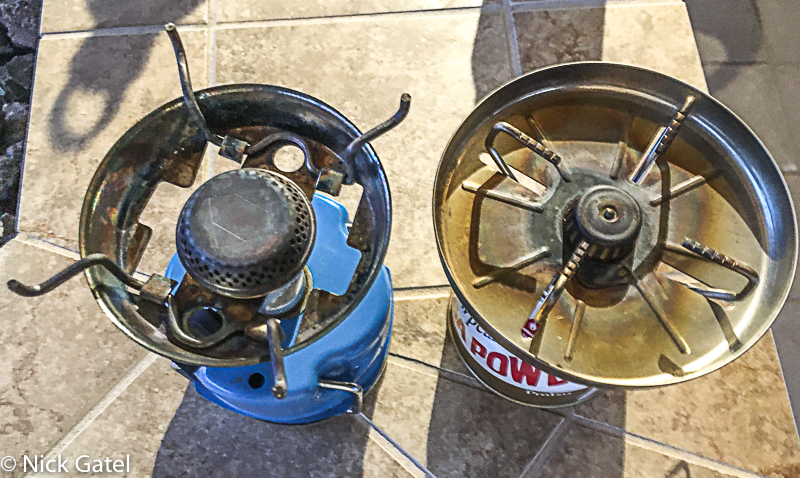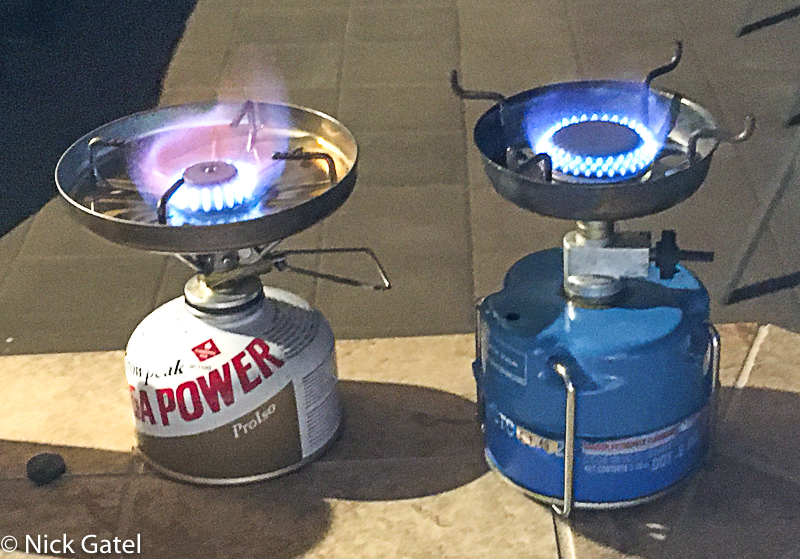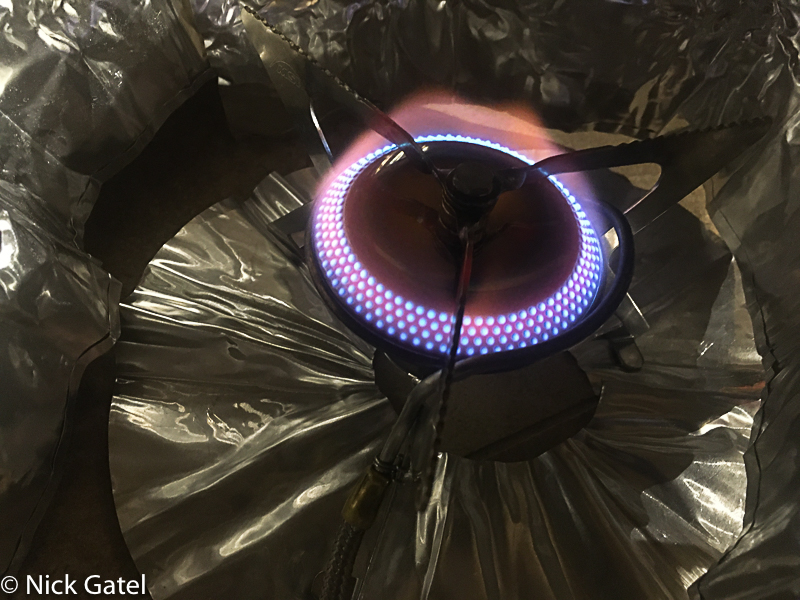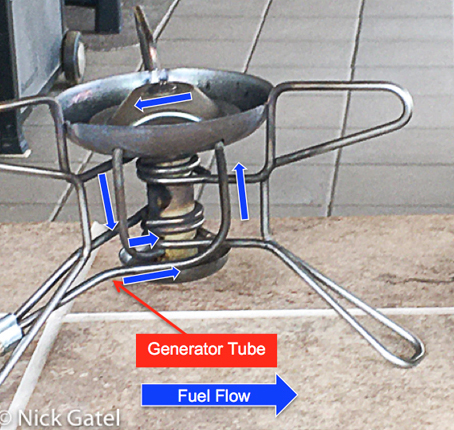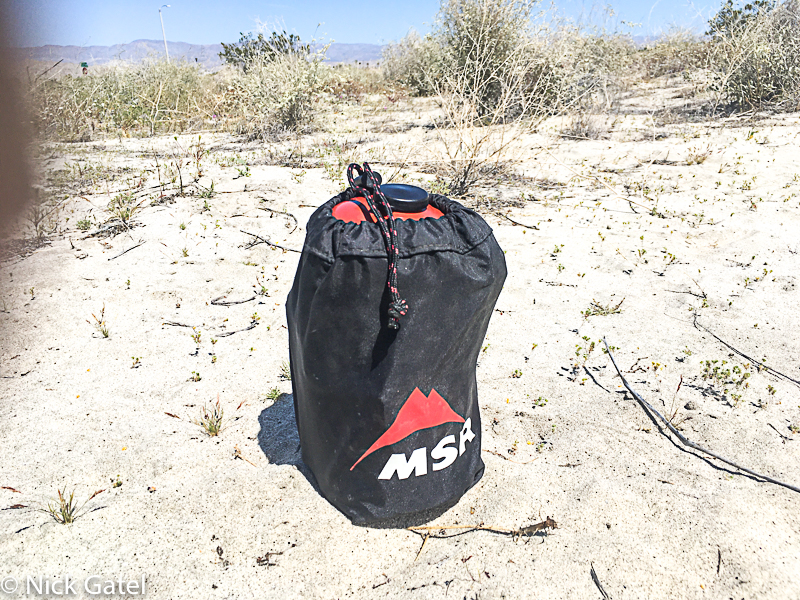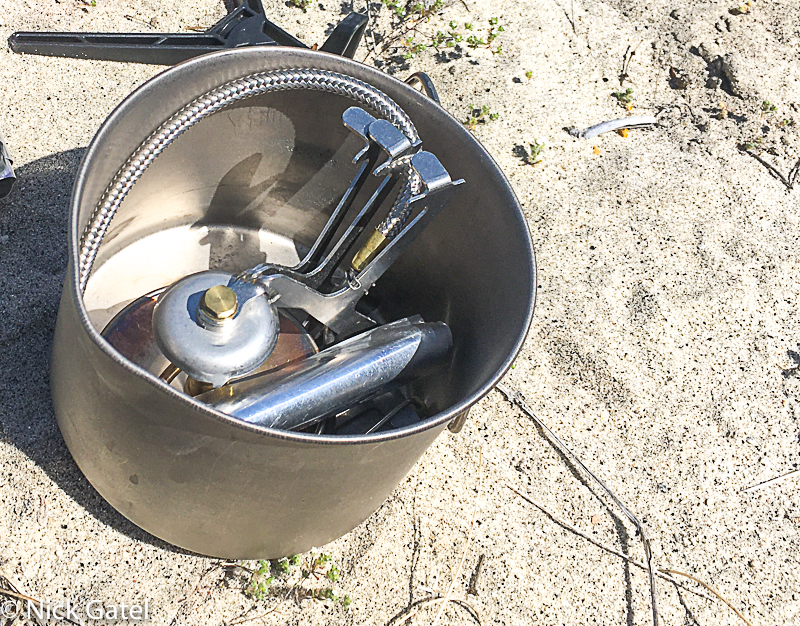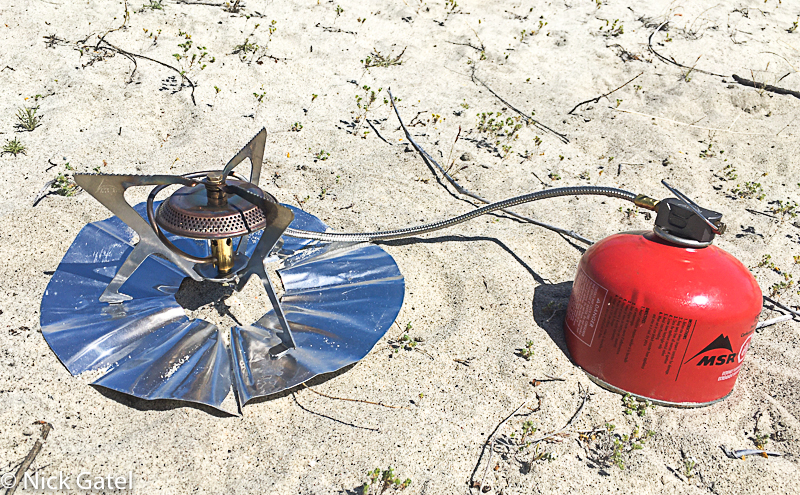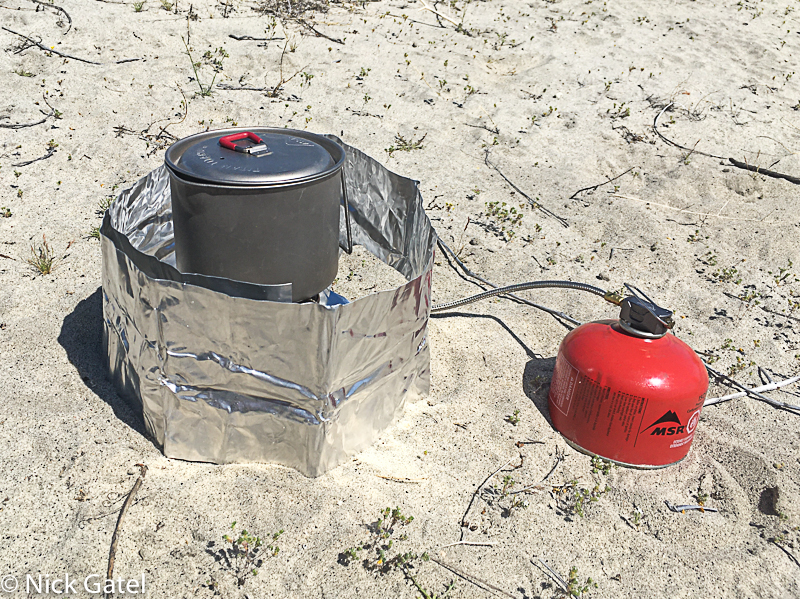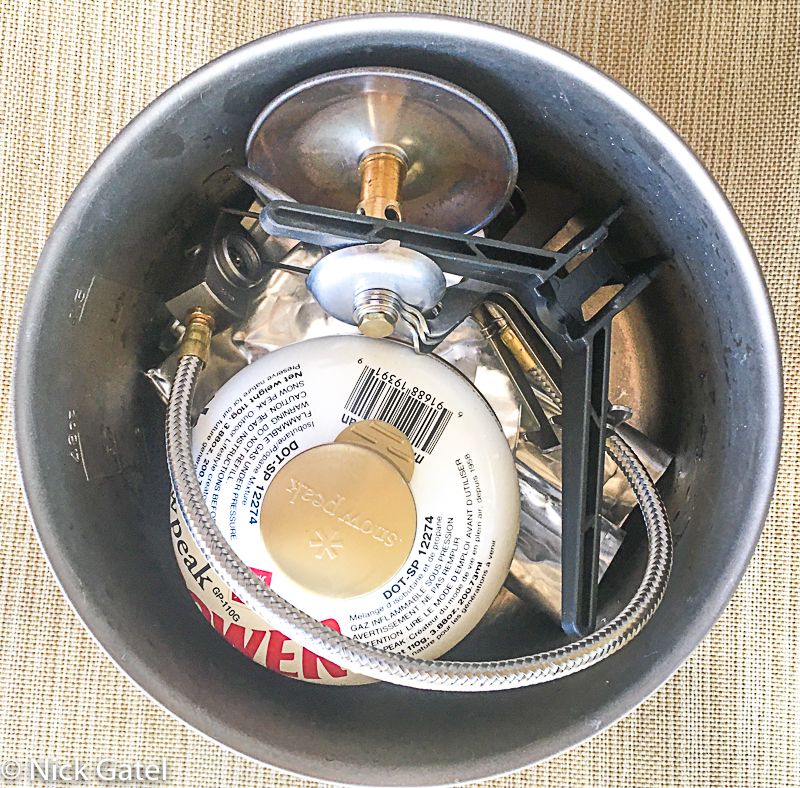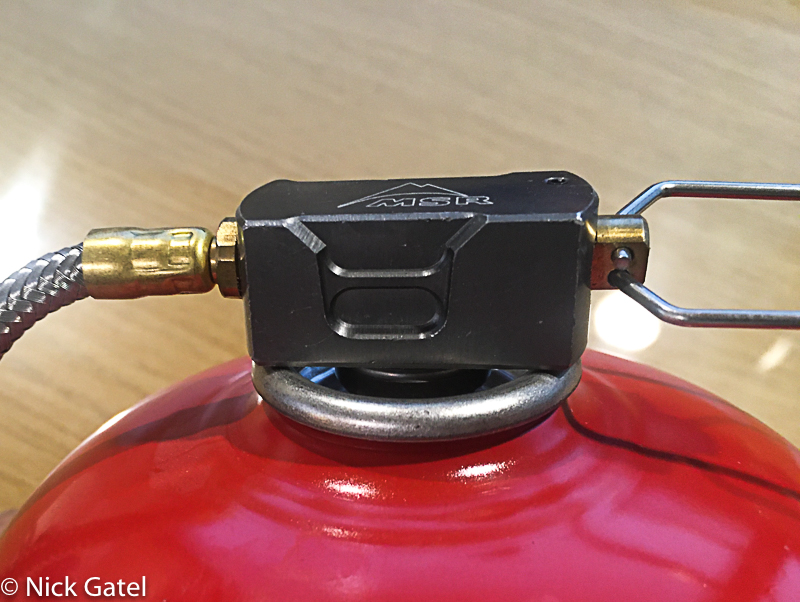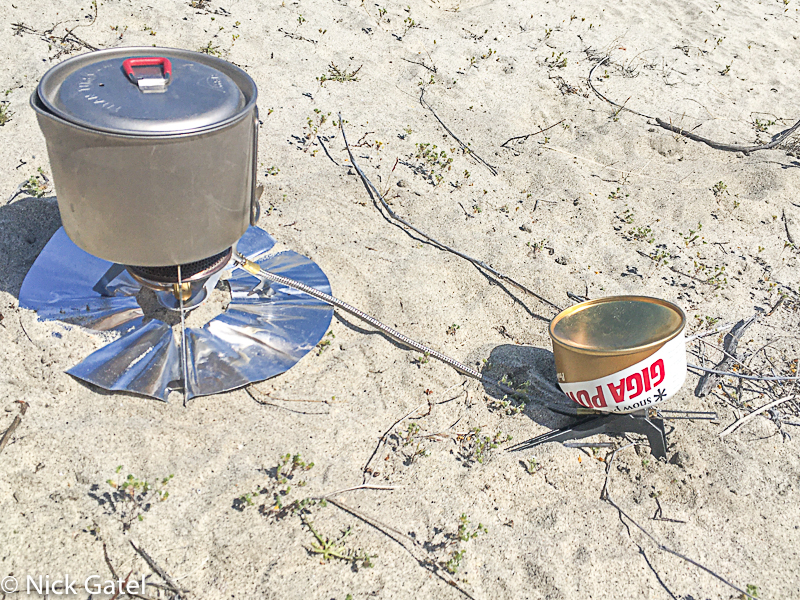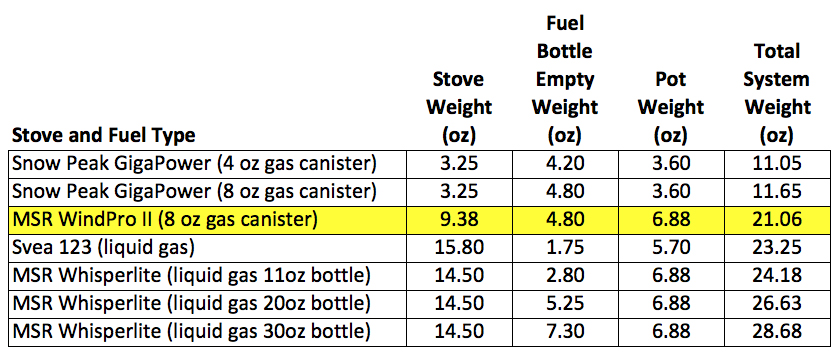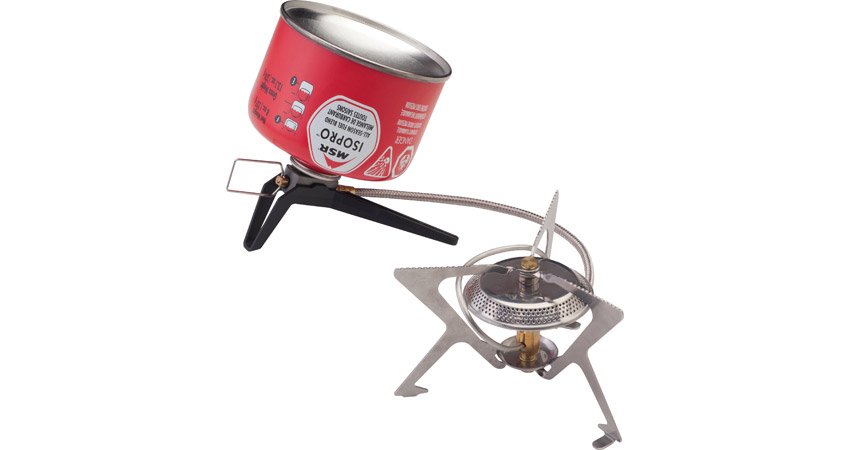
Canister stoves are the most popular type of backpacking stoves these days. These stoves, often called “gas” stoves, have two advantages over “liquid” stoves (i.e. Svea 123, MSR WhisperLite, etc.): They are lightweight and incredibly easy to operate.
However, most suffer several deficiencies:
- Work poorly in windy conditions
- Some have inadequate pot supports
- Some have precarious base support
- Most work poorly or don’t work at all when the ambient temperatures drop below 30° F
The MSR WindPro II solves all these problems. Mitigating the above issues, one might think this is the perfect backpacking stove. Well, maybe. This post will take a journey past to see the evolution of canister stoves, and how they work to help you choose a canister stove if you are in the market to purchase one.
I have been using the WindPro for 10 years now. To be more accurate, I used the WindPro I for two years, gave it away, and bought a WindPro II in 2012. The two versions of these stoves are virtually identical, except the canister connection to the fuel line of the WindPro II swivels, allowing the canister to be inverted. I’ll explain later why this is advantageous. But first we need to understand how backpacking stoves work, which will help us to appreciate the WindPro II.
Problems in the Wind
Or shall we say problems in a slight breeze? This is first and foremost a difficulty most canister stove users experience.
Take a look at these two very popular canister top stoves:

If we take a closer look at the burners of these two stoves (below), we can see the Pocket Rocket (left) has a cup surrounding the burner and the GigaPower’s burner is exposed (right). The Giga Power’s performance is dismal in a breeze, the Pocket Rocket II a little better.

MSR Pocket Rocket II
The instruction manual for the Pocket Rocket II warns:
Never use any kind of windscreen. If you expose the fuel container to high heat, it will explode or leak and you can be killed or seriously burned.
The only “approved” way to decrease the impact of wind on this stove is to try and find a more sheltered location.
Snow Peak GigaPower GS-100
The instruction manual for this stove is pretty clear on the use of windscreens.
It is not noted in the Snow Peak Instruction Manual, but Snow Peak does sell an approved windscreen that fits over the burner and sets over the pot supports.
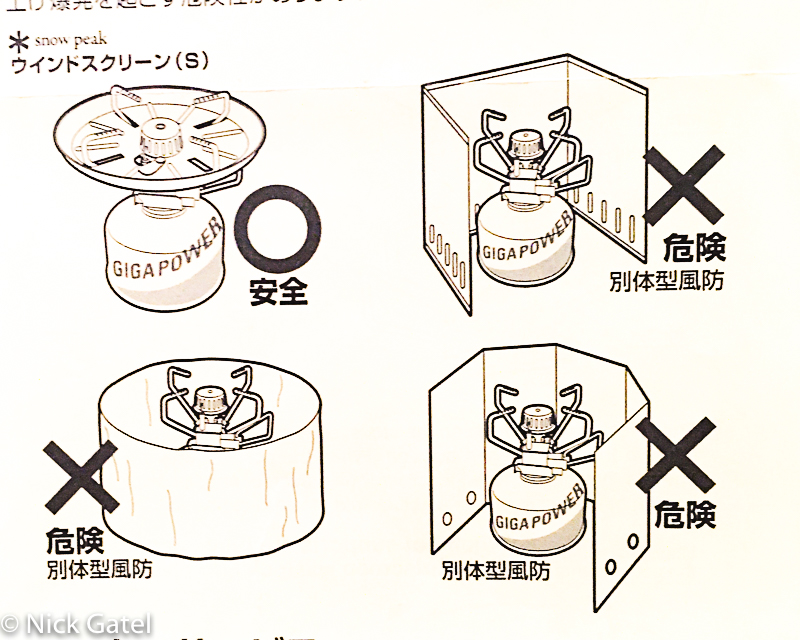
It Snow Peak optional windscreen does work fairly well. The GigaPower stove weighs 2.65 ounces. The windscreen weighs 2 ounces, almost doubling the weight of the stove.
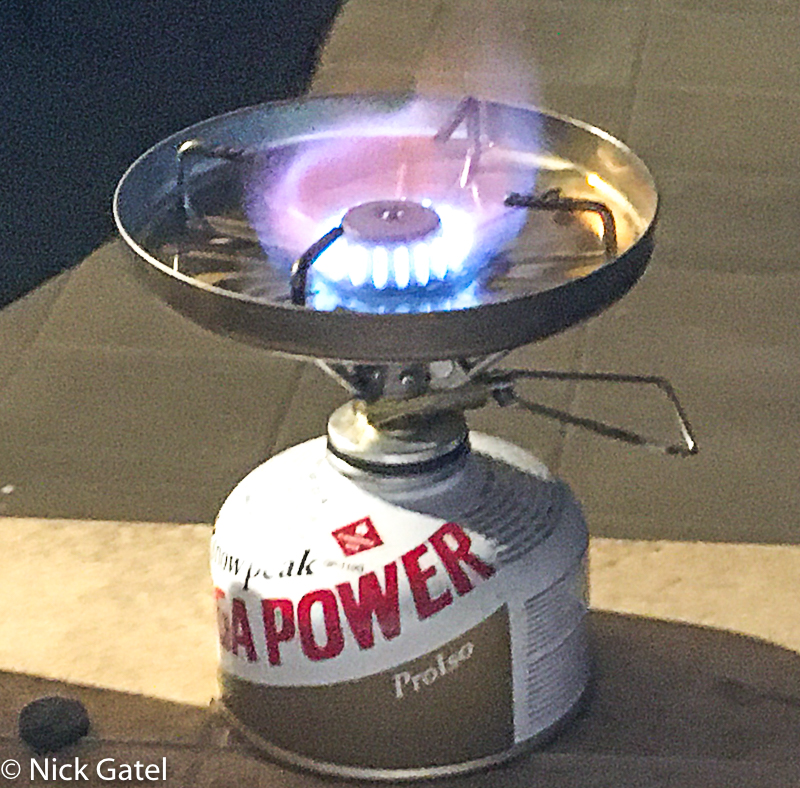
Note how it compares to the old Camping Gaz Globe Trotter (below). Snow Peak’s design isn’t new. What is important is the windscreen is above the canister and below the burner because it is dangerous to overheat a canister.
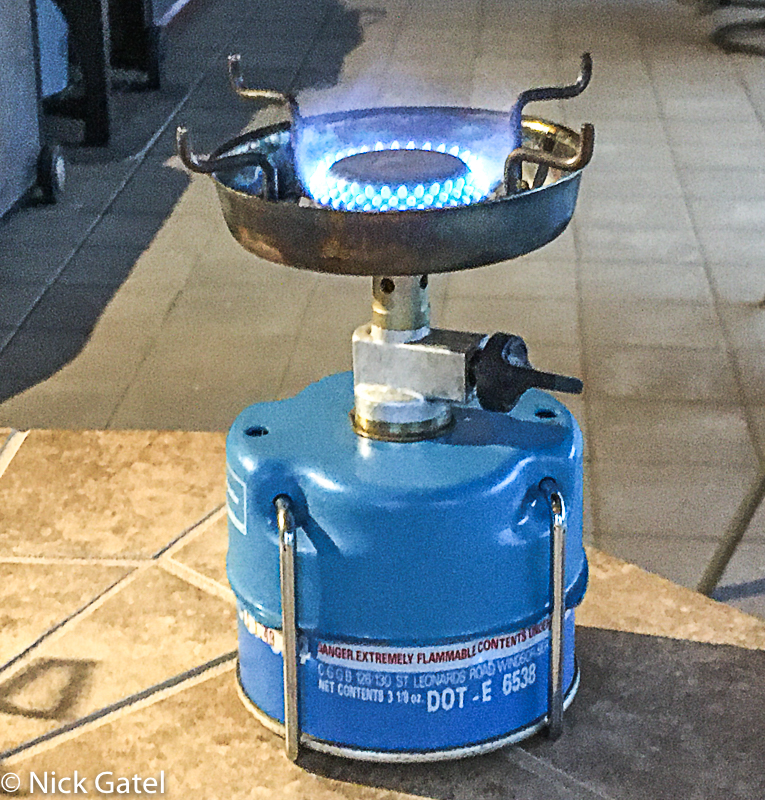
Back in the ‘80s I bought this Globe Trotter stove, which I used on most of my short duration trips for a couple decades (until the canisters became obsolete – although I do still have a few left in my gear locker). The canisters, Gaz GT-106, were filled with butane and did not work well below 40° F, or more precisely, much below 40° F it didn’t work at all. The stove does have a nice windscreen built into the stove.
The next two pictures show the ‘80s Camping Gaz Globe Trotter next to the very popular Snow Peak GigaPower GS-100 with the optional windscreen.
Remote Canister Stoves
Sometime in the ‘90s I purchased a Camping Gas TriStar remote canister stove (note: Gaz was an innovator). This solved the wind problem, except Gaz didn’t include a windscreen – they really missed the boat on this. The Owner Manual doesn’t even mention a windscreen use. It does have a couple warnings: (1) keep the canister and flexible hose away from the flame and (2) the canister cannot be turned over (inverted) when the stove is in use.
Mated with a MSR WhisperLite windscreen it worked well in windy conditions.
This stove used Camping Gaz CV270 and larger CV470 canisters, a blend of butane and propane. The User Manual states it is rated at 10,000 BTU per hour. All I know is it worked pretty darn good down into the 20s Fahrenheit, which was a far cry better than the butane canister stoves I had used previously.
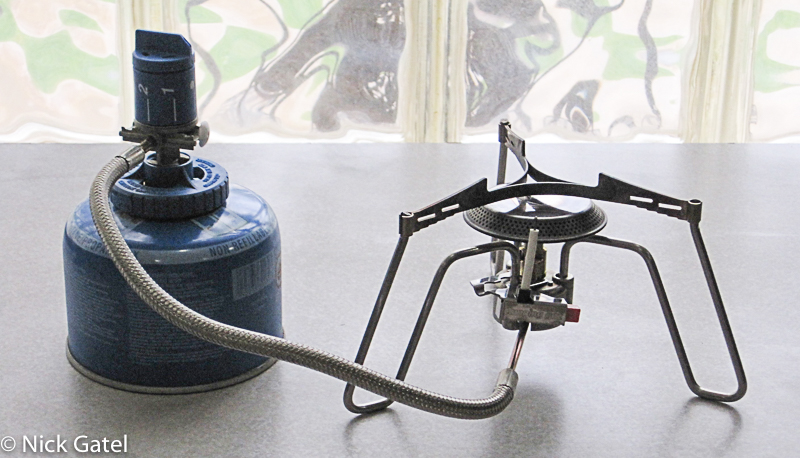
Notice the similarity of the Camping Gaz TriStar (above) to the WindPro II (below).

Wind Test
This evening it was a little breezy in our back yard. I fired up Snow Peak, Pocket Rocket, and WindPro to demonstrate the effect wind has on stoves. Given it was windy and dark, it was difficult to capture good pictures of the stove burners, but I did have to turn the flame up a bit to keep both of them lit.
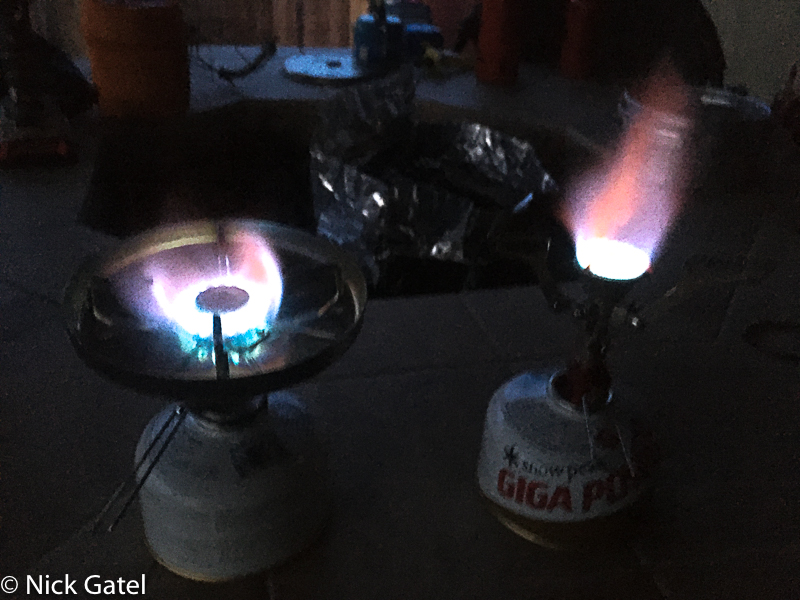
I mentioned earlier that the Snow Peak is dismal in any wind and the Pocket Rocket is a little better. But with the optional wind screen the Snow Peak on the left does much better than the Pocket rocket.
The MSR WindPro is in a completely different class. This stove uses the same windscreen as all the MSR liquid feed stoves. Compared to the two stoves above the flame is has almost no turbulence from the wind.
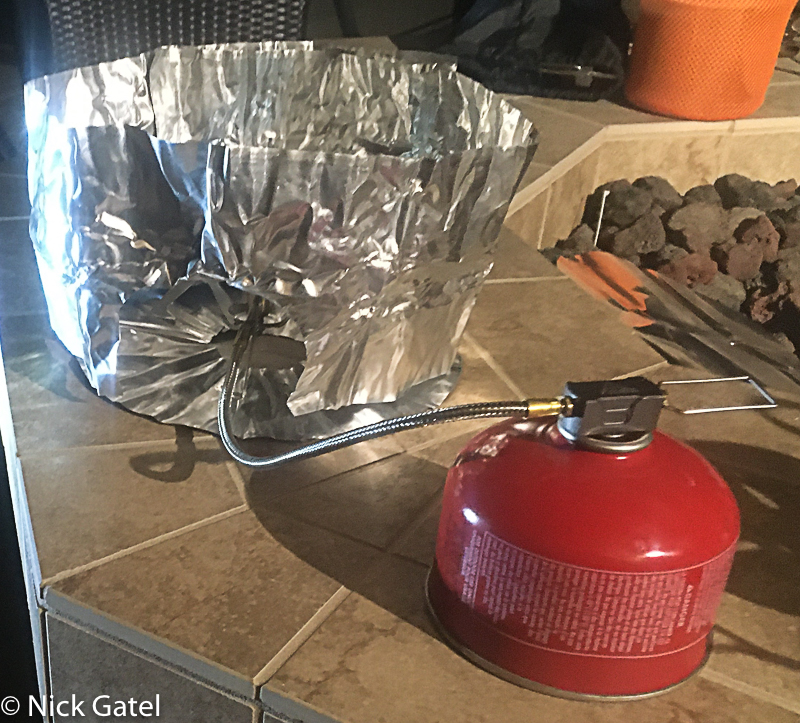
How Backpacking Stoves Work
Whatever the fuel (liquid or gas), the fuel must vaporize above the jet to mix with the air. Too much or too little vaporization causes the burner to be inefficient or not work at all.

Liquid stoves, like the Svea 123 and the MSR WhisperLite accomplish this in two different ways as shown below:
- generator tube
- thermal feedback

Liquid Generator Tube
Liquid stoves like the MSR WhisperLite (above left), feed liquid fuel into a generator tube. Under pressure from the fuel bottle, the white gas passes through the flame area of the stove, which vaporizes the fuel (turning it from a liquid into a gas), from there it flows into and out of the jet allowing the proper amount of vaporized fuel to mix with the air.
Thermal Feedback
The Svea 123 (above right) heats the fuel stem and vaporizes the fuel as it moves through the jet located below the burner flame spreader.
As you can imagine, the fuel is the WhisperLite gets much hotter than the Svea. Because the WhisperLite fuel gets hotter, it works better in cold weather. The WhisperLite generates about 9,500 BTUs per hour, while the Svea generates about one-half that at 4,800 BTUs per hour.
Gas Stove Canister
Most canister stoves do not rely on heating the fuel, in fact, with stoves that attach to the top of a canister, allowing the fuel to get too hot can cause the canister to explode and possibly kill the user – not good, in my opinion.
This diagram from Primus shows how a gas canister works.
The liquid fuel stays at the bottom of the canister and fuel vapors rise to the top and out the stove’s fuel line connections. If the ambient temperature isn’t too cold, the stove operates as designed. This gives canister stoves an easy and convenient method of operation, and allows for extreme lightweight stoves. However if the ambient temperature is too low, the stove will work poorly or not at all. The common IsoPro canisters sold today (a blend of isobutane and propane) have a lower operation limit of around 20° F ambient temperature for an upright canister stove like the MSR Pocket Rocket or Snow Peak GigaPower. Keep in mind that not all canister fuels are equal.
Canister Stove Fuels
Canister stoves are super easy to operate. However the chemistry of operation is very complicated. Too complicated to go into detail here, and, to be honest, I probably don’t entirely understand all of it. So don’t consider this article a definitive essay on portable stove operation.
Popular canister stoves such as the Snow Peak GigaPower and MSR Pocket Rocket use a blend of fuel called IsoPro, which is a blend of isobutane and propane. Depending on the brand, these fuels contain 15% to 20% propane and the rest isobutane.
Let’s take a look at several types of fuel and their “boiling points” at sea level. These boiling points indicate the temperature the fuel will not vaporize very well.
- Propane boiling point: -43° F
- IsoPropane (20/80 mix) boiling point: -11° F
- Butane boiling point: 31° F
Boiling point is only part of the equation. The action of fuel moving out of the canister and vapors rising from the liquid fuel in the canister causes the temperature of the canister to fall. The IsoProp mix above has a boiling point of -11° F, but in actual use the stove’s lower operational level is around an ambient temperature of 20° F, unless special efforts are taken to mitigate the canister temperature drop cause by the movement of fuel. All very complicated, so just note your upright canister backpacking stove isn’t going to work well as the ambient temperature approaches 20° F.
To keep things simple, what do we, as backpackers need to know?
Butane Fuel: When canister stoves first became popular in the ‘70s, almost all of the canisters contain just butane. From a practical standpoint, forgetting all the ”boiling points” discussed earlier, they really didn’t work well or at all when the ambient temperature fell below 40° F. I don’t know of any company selling plain butane or iso butane (butane and isobutane are not identical) in canisters designed to fit today’s backpacking stoves.
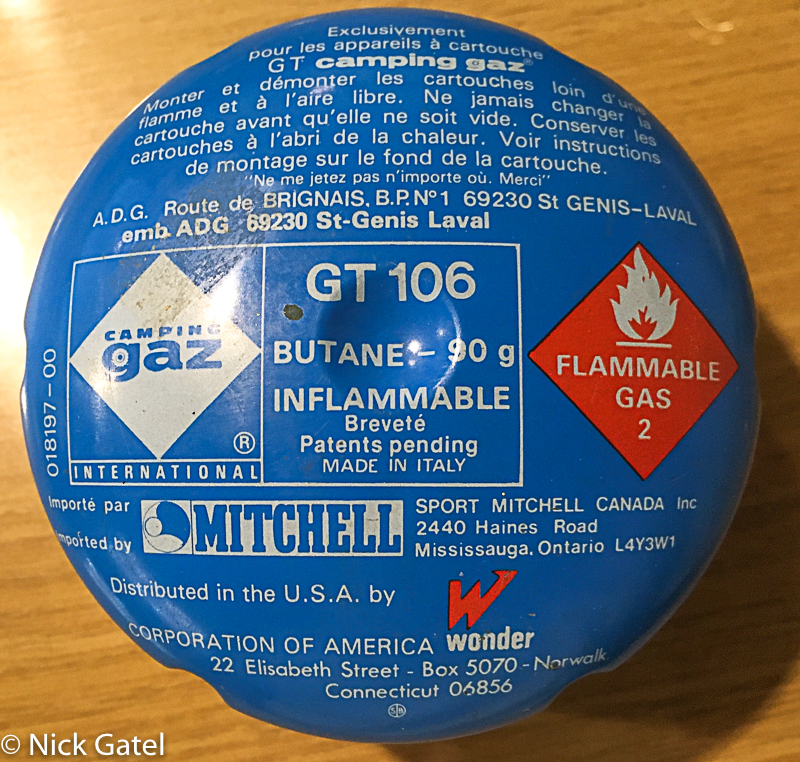
IsoPro Blends: Again, the typical canister stove today uses this kind of blended fuel.
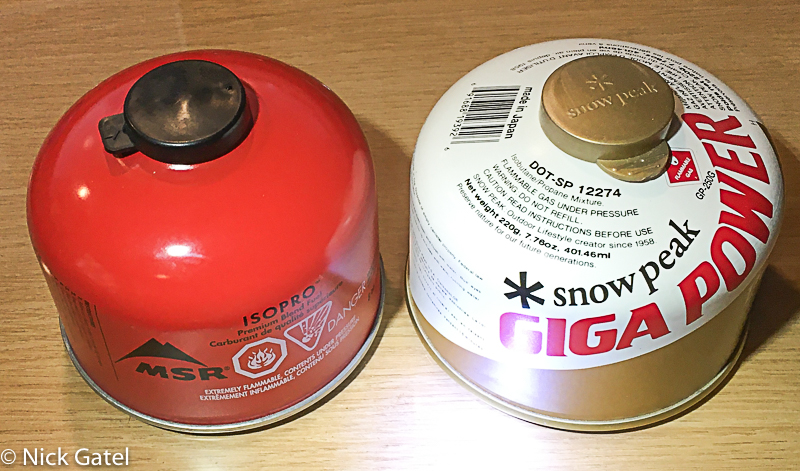
I only use MSR and Snow Peak IsoPro canisters, which do not include the blend amount on the body of the canisters. So, we’ll just have to believe what is published on their websites. Currenty the MSR canisters are 80/20 (80% isobutane and 20% propane) and the Snow Peak are 85/15. For what it is worth, Snow Peak states the lowest operating temperature of these canisters is 15° F. I didn’t see any claims from MSR on their operating temperature specification.
Propane Fuel: For backpackers and campers, these come in those bulky green canisters and contain about one pound of fuel. The canisters are heavy because propane must be stored in liquid form under much higher pressure. Bottom line: these are much too heavy for backpacking use, but if you look at the “boiling points” above, propane is much lower than butane of IsoPro.
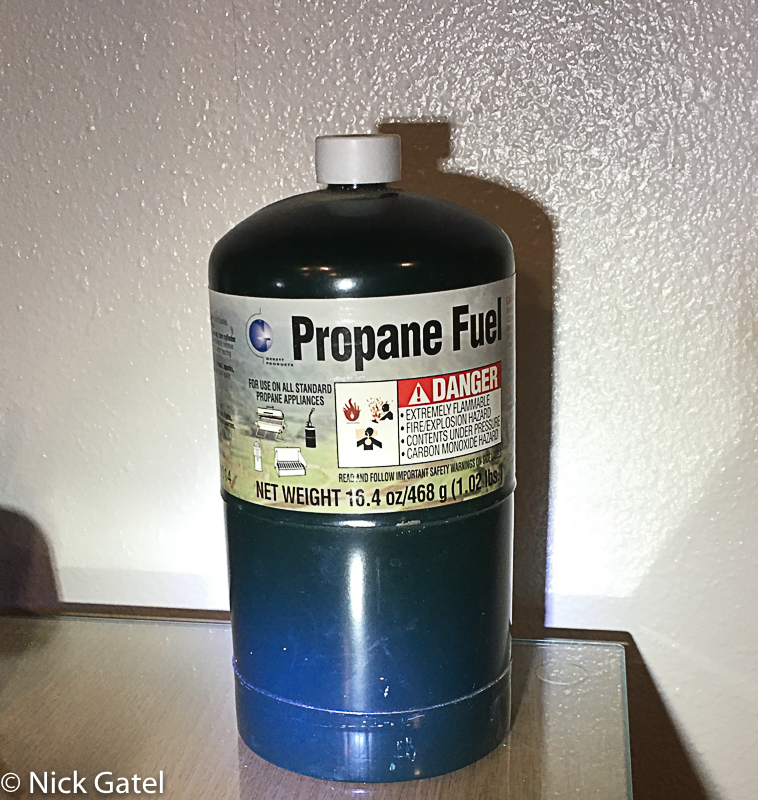
Fuel BTUs
Surprisingly, the IsoPro blends used with today’s canister stoves contain more BTUs (British Thermal Units) than liquid fuels (i.e., Coleman white gas, etc.). A BTU is the amount of energy (or heat) required to raise the temperature of one pound of water at sea level one degree Fahrenheit. This definition is not important to most of mere mortals who are only concerned that our backpacking stove works when we need it to work. Many people, who use backpacking stoves, are surprised to learn these blended canister fuels contain more BTUs than white gas, because in the field white gas seems to work better, although white gas stoves are heavier and not as convenient.
IsoPro canister fuel contains around 21,000 BTUs per pound of fuel versus white gas at approximately 19,000 BTU per pound of fuel. But this is just part of the formula to shop for the best stove to meet your needs.
The stove burner construction, fuel delivery system, and other factors determine the rate BTU of a stove. For example, as mentioned earlier, a Svea 123 liquid fuel stove puts out about 4,800 BTUs per hours, a MSR WhisperLite liquid fuel stove about 9,500 BTU per hours, and a MSR WindPro II IsoPro gas stove up to 10,000 BTU per hour.
WindPro Surprise
Back in 2010 I was in a REI store and saw the new WindPro stove on display. I wasn’t in the market for a new stove, but something on the WindPro caught my eye. Do you see it?
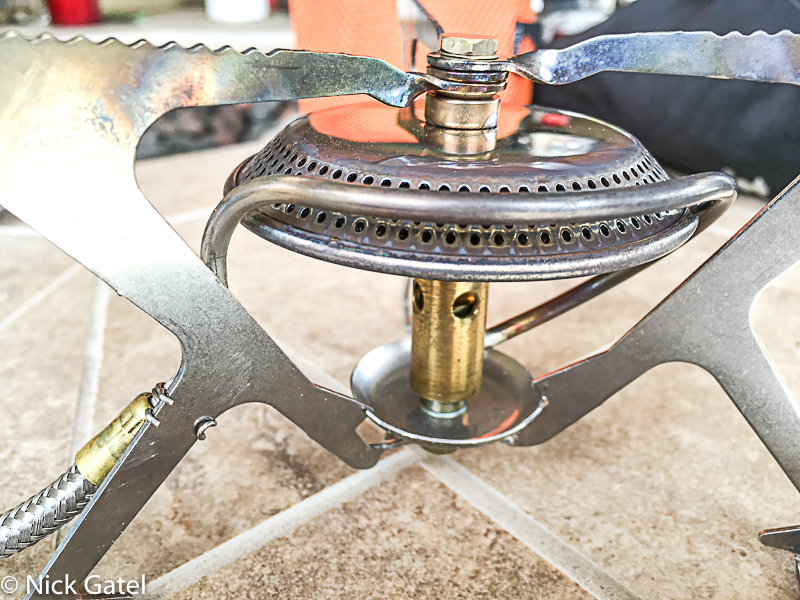
If you don’t see anything special about the WindPro, take a look at this side-by-side comparison of the Gaz TriStar and the WindPro.
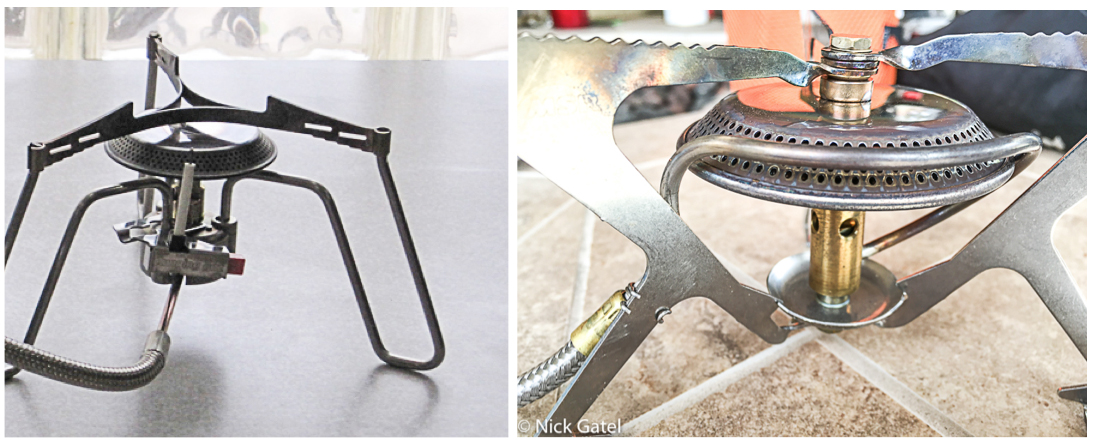
Still don’t see it. How about a side by side view of the MSR WhisperLite and the WindPro below.

You’ll notice that the fuel line for the WindPro goes up across the burner and then down to stem below the jet. This means the burner is heating the fuel in the fuel line. This had significant possibilities that were not mentioned in the Owner Manual.
Earlier I showed a diagram of how the liquid fuel travels through the generator, which is heated by the burner to turn the liquid into a gas. Let’s take another look at that MSR WhisperLite liquid gas stove and how the fuel is delivered to the burner (see below).
I also posted a picture from the Primus website of how a canister works. I’ve cropped it and placed it below.
What would happen if we inverted the canister; that is, turned it upside down?
The liquid would settle to the bottom, where the fuel line fitting connects, meaning we would feed liquid into the stove, instead of vapor.
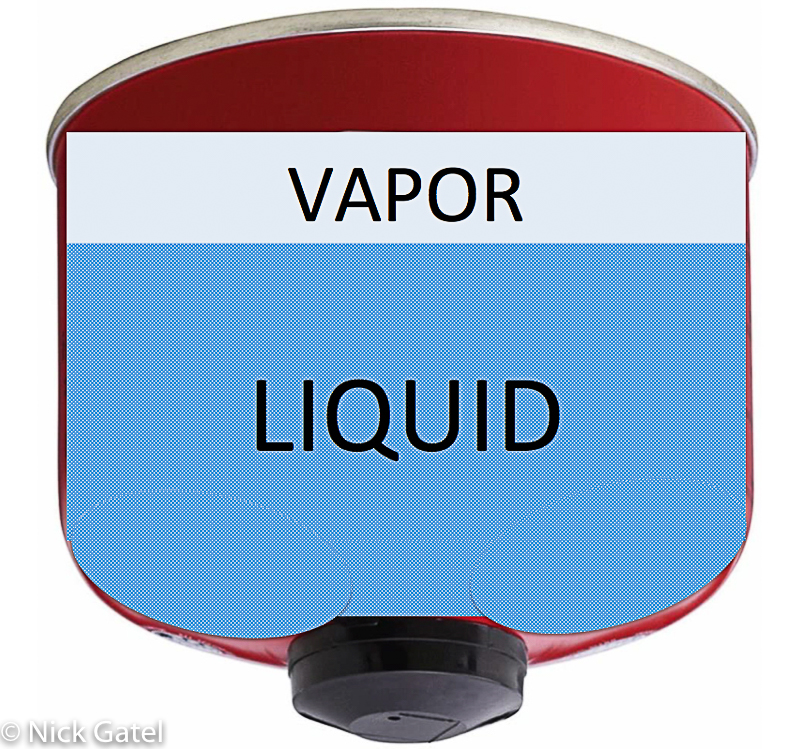
Feeding liquid IsoPro into a cold stove would be a disaster. You would have one hell of a fireball momentarily, until the fire entered the canister and caused an epic explosion.
Feeding liquid white gas into a cold stove would also be a disaster.
How do we get away with feeding liquid white gas into a stove such as the MSR WhisperLite?
In my review of the MSR WhisperLite liquid gas stove, I reviewed the necessary steps to priming the fuel and warm up the stove to feed liquid white gas to the burner. The steps are:
- Pressurize the fuel bottle with the pump
- Open the control valve until the priming bowl fills up with ½ spoonful of fuel
- Close the fuel valve (the fuel line will now be full of fuel, but will not continue to feed into the stove)
- Light the priming bowl (this heats the fuel line generator)
- Just before the priming flame goes out, open the valve
- The burner will now light and the heat turns the liquid fuel into a vapor
- The correct amount of vaporize fuel passes through the jet to mix with air
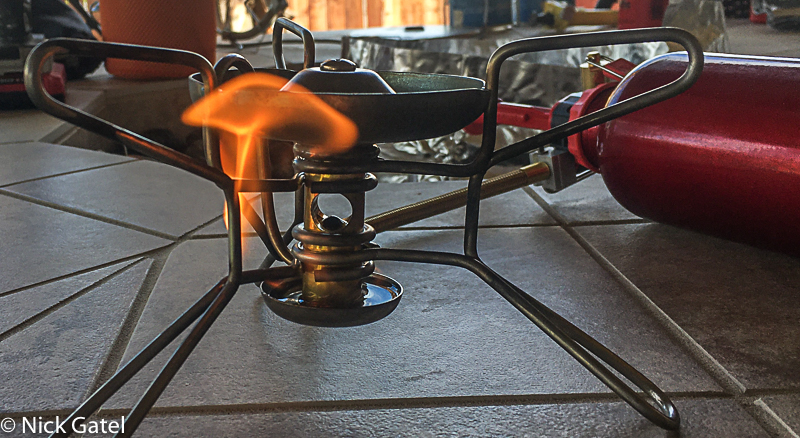
There is one more problem if we invert the fuel canister of the WindPro stove.
The WindPro doesn’t have a priming bowl.
However, if we just run the stove with the canister upright, in about 60 seconds the burner and fuel tube will be hot enough to invert the canister… carefully invert the canister and keep an eye on the flame because the flame will flare up a bit as liquid fuel (instead of vapor) is feed into the fuel line at the canister connection. As you are inverting the canister, adjust the flame.

Now put the windscreen around the stove. You have a set up just like a WhisperLite, with the advantage of IsoPro having more BTUs than white gas, plus the WindPro can be adjusted to simmer a little better than the WhisperLite, though neither are stellar simmering stoves.
In essence you have a better stove – almost.
I have never used the WindPro below 20° F, but users have reported good results down to -20° F. There are a lot of variables for minimum temperatures, especially the altitude the stove is operated at. A white gas liquid stove is going to work down to -40° F or even lower depending on conditions.
Keep in mind that my first WindPro, now considered the WindPro I, was not marketed as a stove that could be used with the canister inverted. In fact, it was a little difficult to invert, because the braided fuel line would twist. I had to prop the canister with a drinking cup to keep the canister inverted.
WindPro II
In 2012, MSR released this stove, with a canister connector that could swivel, making it easy to invert. Also, MSR now marketed it as such. So I bought one. Comparing it to the WindPro I, it looked exactly identical. I gave the original WindPro to a friend and kept the newer version.
MSR liquid stoves and the WindPro come with a heavy duty-carrying bag. I don’t use it with my liquid stoves, preferring to store the stove and accessories in a pot to better protect everything and save space. When I use a small pot, such as a 850 ml MSR Titan Kettle, I can put everything into the carrying bag that comes with the stove, including an 8 ounce IsoPro fuel canister.
Some notes on the windscreen above, used for illustration purposes. It is best to adjust the windscreen 1 inch from the pot. Even if there is no wind, the stove will operated more efficiently with the windscreen in place.
Pots
The WindPro II can handle pots up to 10 inches in diameter (per the User Manual). With the larger burner (compared to most upright canister stoves), wide shallow pots are most efficient (not the tall Titan Kettle show in the pictures above). Below is the WindPro II and all accessories in a 1.5 liter pot that has a 7 inch diameter. I can also fit a small 4 ounce canister in the pot (the larger 8 ounce is too big).
Canister Stand for Inverting the Canister
This is a nice addition and weighs ½ ounce.
Weight
The stove, windscreen, and stand come in at 9 3/8 ounces (267 g). The table below will give the reader a comparison to some other stoves.
Efficiency
There are two things I see measured when it comes to stoves. How long to boil 1 liter of water, and how long does the fuel last (burn time per ounce of fuel, or some other arbitrary metric). In all honesty it’s a bunch of crap. You can’t trust the manufacturers (except the maker of the Svea 123 who states the stove boils a liter of water in 7 minutes). Can we trust Internet people, like me, reviewing a product? Are they matching the perfect pot to each individual stove? And so on.
I can tell you my WindPro boils water a little faster than WhisperLite. And we can’t really do much useful testing between a canister stove and a liquid stove, even when the are so similar, like the WindPro and the WhisperLite.
To me, a meter metric is how much does it cost per day to operate (e.g., fuel cost per day. This table shows my costs and is the reason I have mostly been using white gas and alcohol the past few years. I do have a stock of the other types of fuels and still use all the stoves listed.
Some Thoughts on Canisters
Hands down, canister stoves and the most convenient and fool-proof (assuming the operator isn’t an idiot and follows the instructions) type of stove. A remote canister stove than can use an inverted canister is as good, or maybe better, than a similar liquid fuel stove.
But canister fuel is expensive compared to white gas or alcohol. Then there is the problem of disposal. I hate to buy anything disposal (except for toilet paper). So make your decisions based on your own value system, assuming you have one.
Canister Fuel Quality
When canisters are used in an upright position, possible contaminants are difficult to get into the stove. Using a canister inverted is a different matter. I have read many stories of poor quality canister fuels clogging a stove. Most canister stoves are not field repairable and most do not have available replacement parts should your stove become plugged. For this reason, I only use MSR and Snow Peak canisters. Personal opinion. Personal prejudice. For what it’s worth.
Other Brands of Remote Canister Stoves
I have had a lot of experience with MSR stoves and feel most are excellent, reliable appliances. There are other well known and good performing stoves on the market.
But this isn’t a product review site. I will review a product if it has stood the test of time, and I am not going to buy something just to review it, or accept a product from a manufacturer for review. So, do your research.
This website may be compensated for linking to other sites or for sales of products. As an Amazon Associate I earn a small fee from qualifying purchases at no additional cost to the purchaser.
Auto Amazon Links: No products found.
